Surrounded by the peaks of the Andean Plateau and overlooked by the 6402m Mt. Illimani, La Paz is a truly breathtaking city whose buildings sprawl across the surrounding canyon, reaching altitudes of up to 4100m. While the sight of the city is reason enough to visit, La Paz holds a number of attractions sure to keep tourists fascinated. Take a walk along Calle Jaen, a colonial street lined with museums, explore the city's cathedrals or wander through some of the colourful markets, including the 'Witches' Market' where llama foetuses and dried frogs can be found for sale.



On the shore of Lake Titicaca lies the original Copacabana. For centuries, this small Bolivian town has been a sacred destination, with pilgrims flocking to visit the famed Camarin de la Virgen de Candelaria, a statue considered to have miraculous powers. Visitors to the town can see the renowned figure in one of the oldest churches in the country and take in stunning views on the Cerro Calvario hill, a climb which includes Stations of the Cross often frequented by the faithful. The town has numerous festivals where local Aymara women take to the streets, dancing in their traditional colourful dresses and bowler hats.



The largest island on Lake Titicaca, the “Island in the Sun” is an ancient holy Inca site with over 80 ruins dating back to the 15th century AD. The rocky piece of land can only be explored by foot and there are several walking tracks to help visitors get around. Among the Inca monuments, tourists will find the Inca Table, a platform thought to have been used for human sacrifices; the remains of a two-story palace; and a set of rock impressions dubbed The Footsteps of the Sun. The island also boasts an Inca gold museum and a spring that the Spaniards thought to be the fountain of youth.



As previously described



Chuvica is a small settlement in Bolivia, set on the southern edge of the Uyuni Salt Flats, the largest salt lake on earth. This little town serves as a base for tours and expeditions of the extraordinary natural area, which also boasts spectacular rugged hills strewn with desert vegetation, making it an ideal destination for photographers and outdoor enthusiasts. The salt lake, often nicknamed ‘the largest mirror in the world’, offers an unusual and phenomenal experience up close with nature. Spreading over more than 10,000 square kilometres, backed by striking mountains, and decorated by exquisite patterns made by the salt, this is one of the country’s top must-see attractions. Set between Bolivia, Chile, and Argentina, this location is also ideal for travellers wishing to explore the fascinating neighbouring countries.



Villamar Mallcu is located in the remote vast plains of Southwestern Bolivia, on the northwestern edge of the Cordillera de Lipez. The striking landscapes are characterised by strange volcanic rock formations, bubbling turquoise hot springs and multi-coloured sands, and are home to ancient rock paintings (Pinturas Rupestres). The small town boasts a vibrant craft market selling an incredible collection of finely made artisanal crafts. The Andina Eduardo Avaroa National Fauna Reserve is a short drive away, offering the chance to see flocks of pink flamingos, herds of vicuna grazing the Altiplano, 80 species of birds, as well as the shy viscachas and Andean foxes.
The small town of San Pedro de Atacama is a scenic oasis in the Atacama Desert, surrounded by the imposing volcanic peaks of the Chilean altiplano and located close to several major archaeological and natural attractions. The fascinating ancient sites of Tulor and Quitor, the enthralling Atacama Salt Flat, the jaw-dropping turquoise Altiplanic Lagoons, and the other-worldly Tatio Geysers all lie nearby, and as a result, the village has become a significant tourist destination. Despite its small size it encompasses a wide range of restaurants; however, it is also known for its ‘western feel’ and retains an old-world charm. History enthusiasts will enjoy a visit to the atmospheric 17th-century Iglesia San Pedro. However, it is really the breathtaking surroundings that make this destination special.
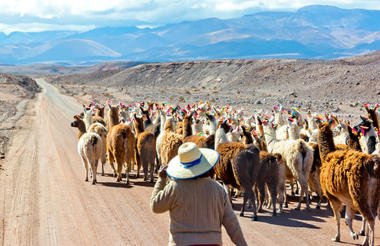
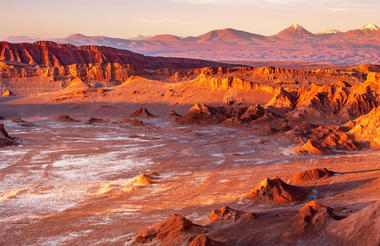
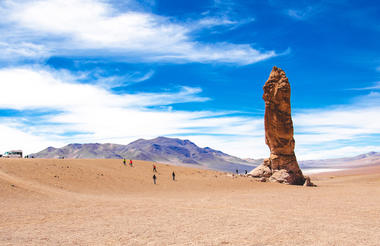
An enticing mix of historical architecture, picturesque views and sprawling vineyards await travellers to Salta, located in the lovely Lerma Valley in the Andean foothills. Simply wandering through the streets of the central city area will take you past a variety of impressive 18th and 19th-century buildings, including the neoclassical Cathedral of Salta, the ornate Church of Saint Francis and the Museum of High Mountain Archaeology – housing a collection of ancient Inca relics. Other popular attractions are the area’s array of exceptional wineries, and the panoramic views over the region visitors from the top of San Bernado Hill.



Cafayate is jaw droppingly beautiful. Vibrant rows of grapevines contrast against the stark ridges and undulating mountain scenery, making travelling to the northern echelons of Argentina well worth it, and this small town attracts wine enthusiasts and naturalists alike. Don’t miss out on the striking geological folds of the Cafayate Amphitheatre or hiking the six-kilometre trail that follows the Colorado River. Wine-loving visitors will be rewarded with lip smacking Torrontes wine, an Argentinean white varietal that can be found in many of the cool bodegas (cellars) around town, while those arriving by road from Salta will enjoy the spectacular views along the scenic National Route 68.



Resting at the confluence of the Parana and Iguazu rivers, Puerto Iguazu is a charming tourist city that serves as the gateway to Iguazu Falls on the Argentinian side of the border. It is surrounded by red rocky landscape interspersed with verdant forest inhabited by abundant wildlife. The city is a popular tourist destination and draws visitors from around the globe to visit the Iguazu National Park and its breathtaking waterfalls. Visitors can also explore the spectacularly scenic surroundings through a variety of activities including: jumping on one of the many tours on offer, enjoying an array of outdoor activities, visiting the Guira Oga - 'The House of Birds', and soaking up the views from the Hito de las Tres Fronteras, a magnificent natural park.



Foz do Iguacu is an important Brazilian town within the state of Parana, set close to the three-way border between Brazil, Argentina and Paraguay. Explore the incredible natural wonders of the UNESCO-listed Iguazu National Park, which offers the chance to see not only the enormous cascading waterfalls (one of the largest in the world) but also numerous rare and endangered plants and animals. At the Bird Park, see bright and beautiful winged species. Marvel at the architecture, atmosphere and sacred ceremonies at the Buddhist Temple and Omar Ibn Al-Khattab Mosque. Delve into local heritage by attending the mesmerising Ipora Show, a celebration of culture through story, song and dance. Other highlights include the Three Borders Landmark, Itaipu Dam, and Dreamland Wax Museum.



A dynamic coastal neighbourhood synonymous with leisure, luxury and nightlife, Copacabana is characterised by million-dollar penthouses, stunning neoclassical buildings and tiny apartments set against a magnificent backdrop of jungle-clad mountains in Rio de Janeiro. From its humble origins as a small fishing village, the "Princess of the Sea" is now a leisure seeker's paradise, bursting with restaurants, nightclubs, bars and hotels, and emits a lively, effervescent energy, perfect for the social traveller. To learn its history, visit Forte de Copacabana, a fort and museum that traces the early days of the Portuguese colony through to the mid-19th century. Art enthusiasts will appreciate a visit to The Eva Klabin Foundation (Casa Museu Eva Klabin), a historical home of famous art and antique collector Eva Klabin that houses over 1000 art pieces from all over the world. A visit to Copacabana is incomplete without the world-famous Copacabana Beach, a 4-kilometre stretch of golden sand dotted with brightly-coloured umbrellas, bars and a popular playground for watersports, football, volleyball, or simply lazing in the sun.
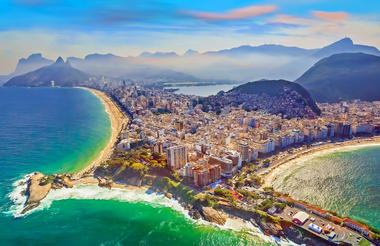
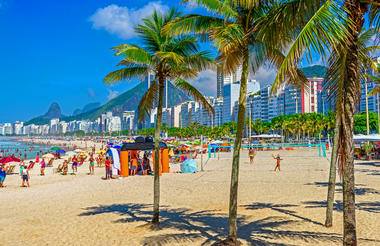
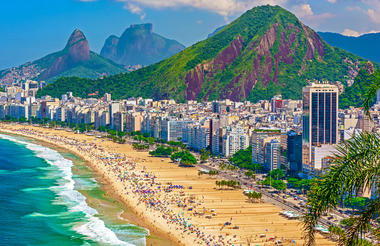
Situated in the Brazilian state of Rio de Janeiro, Angra dos Reis encompasses 365 small picturesque islands and it is also the name of the town which serves as an excellent jumping off point for visitors wishing to explore the beautiful island of Ilha Grande. Renowned for its natural beauty and pristine beaches, the area boasts over 2000 magnificent beaches lapped by impossibly blue crystalline waters. Visitors flock here to immerse themselves in this picture-perfect beach paradise, explore adventure trails, discover waterfalls and view the mansions of the rich and famous dotting private islands. Other popular activities include: swimming, snorkelling, diving, boating, and lazing on idyllic beaches.








